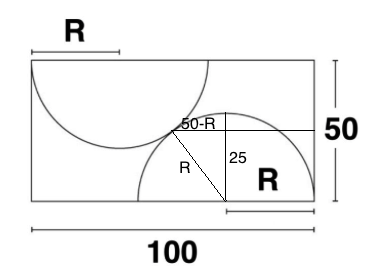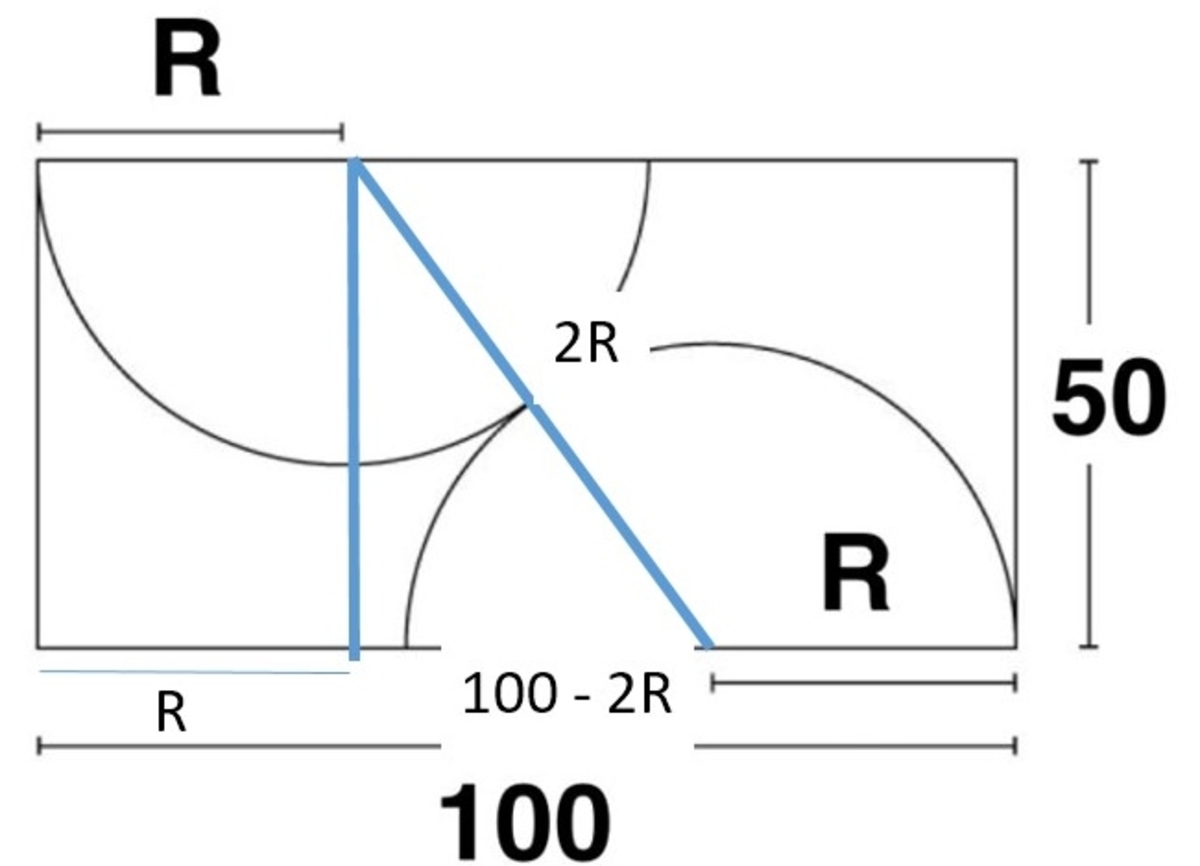Two Kissing Semicircles

From the picture given above, find 4 R .
The answer is 125.
This section requires Javascript.
You are seeing this because something didn't load right. We suggest you, (a) try
refreshing the page, (b) enabling javascript if it is disabled on your browser and,
finally, (c)
loading the
non-javascript version of this page
. We're sorry about the hassle.
7 solutions
How do you know that x=100-3r?

By symmetry, the intersection of the two circles must lies at the center of the rectangle. If we draw in lines to form this triangle, we can solve for R: R 2 = ( 5 0 − R ) 2 + 2 5 2 = > R=125/4 = > 4R=125
We can use this relation to represent a circle.
( x − h ) 2 + ( y − i ) 2 = r 2
Where h and i respectively denote the translation in the x and y directions on a Cartesian plane.
If we take the circle on the bottom for instance, it is plain to see that there is no vertical translation and the horizontal translation must be 1 0 0 minus the radius.
Therefore, h = 1 0 0 − r and i = 0
From here we can sub in the point of intersection between the two circles ( 5 0 , 2 5 )
( 5 0 − ( 1 0 0 − r ) ) 2 + ( 2 5 − 0 ) 2 = r 2
2 5 0 0 + 1 0 0 r + r 2 + 6 2 5 = r 2
3 1 2 5 + 1 0 0 r = 0
r = 3 1 . 2 5
4 r = 1 2 5
*Thank you for the correction.
Simply a typo I'm sure, but the equation after substituting the point should be ( 5 0 − ( 1 0 0 − r ) ) 2 + ( 2 5 − 0 ) 2 = r 2 which would give you a − 1 0 0 r term instead of a + 1 0 0 r term in the next line. That way, when you solve for r , you don't end up with a negative answer like you should have in your current calculation.

- ( 2 R ) 2 − 5 0 2 = ( 1 0 0 − 2 R ) 2
- 4 R 2 − 2 5 0 0 = 1 0 0 0 0 − 4 0 0 R + 4 R 2
- 4 0 0 R = 1 2 5 0 0
- 4 R = 1 2 5
Let x and y be the horizontal and vertical distances respectively between the centre of a semicircle and the point of tangency. This gives us 2 R + 2 x = 1 0 0 ⇒ x = 5 0 − R 2 y = 5 0 ⇒ y = 2 5 Squaring and combining these equations gives us x 2 + y 2 = 2 5 0 0 − 1 0 0 R + R 2 + 6 2 5 But by the Pythagorean theorem, x 2 + y 2 = R 2 , so R 2 = 3 1 2 5 − 1 0 0 R + R 2 ⇒ 1 0 0 R = 3 1 2 5 ⇒ 4 R = 1 2 5 .
it just solve this: 1 0 0 − 2 r = ( ( 2 r ) 2 − 5 0 2 )
@凯耀 郑 Hi, if you are not familiar with latex, read this . Thanks!
Hmm yeah actually, LOL
BTW, when you are comenting, use LaTeX
x = 1 0 0 − 3 r
Through the Pythagorean theorem, we can obtain the following equation :
5 0 2 + ( x + r ) 2 = ( 2 r ) 2
Previously, we already know that x = 1 0 0 − 3 r So,
5 0 2 + ( x + r ) 2 = ( 2 r ) 2
5 0 2 + ( [ 1 0 0 − 3 r ] + r ) 2 = ( 2 r ) 2
5 0 2 + ( 1 0 0 − 2 r ) 2 = ( 2 r ) 2
2 5 0 0 + ( 1 0 0 0 0 − 4 0 0 r + 4 r 2 ) = 4 r 2
1 2 5 0 0 − 4 0 0 r + 4 r 2 = 4 r 2
1 2 5 0 0 = 4 0 0 r
r = 4 1 2 5
4 r = 1 2 5